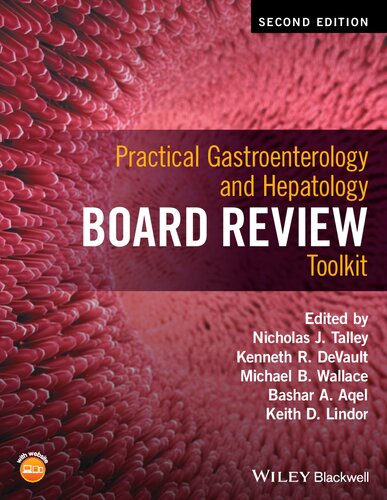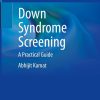Practical Gastroenterology and Hepatology Board Review Toolkit 2nd Edition by Nicholas Talley, Kenneth DeVault, Michael Wallace, Bashar Aqel, Keith Lindor ISBN 9781118829080 1118829085
$50.00 Original price was: $50.00.$25.00Current price is: $25.00.
Practical Gastroenterology and Hepatology Board Review Toolkit 2nd Edition by Nicholas Talley, Kenneth DeVault, Michael Wallace, Bashar Aqel, Keith Lindor – Ebook PDF Instant Download/Delivery: 9781118829080 ,1118829085
Full download Practical Gastroenterology and Hepatology Board Review Toolkit 2nd Edition after payment

Product details:
ISBN 10: 1118829085
ISBN 13: 9781118829080
Author: Nicholas Talley, Kenneth DeVault, Michael Wallace, Bashar Aqel, Keith Lindor
Practical Gastroenterology and Hepatology Board Review Toolkit 2nd Edition Table of contents:
Section I How to Ace the Boards in Gastroenterology and Hepatology
1 Introduction and Overview of the Gastroenterology Boards
What to Expect at the Test Center
The Examination
Maintenance of Certification Changes
Specific Tips and Recommendations for the Gastroenterology Board Examination
Reference
Section II Esophagus and Stomach
Part 1 Pathobiology of the Esophagus and Stomach
2 Anatomy, Embryology, and Congenital Malformations of the Esophagus and Stomach
Summary
Anatomy
Embryology
Congenital Malformations of the Esophagus and Stomach
References
3 Esophageal and Gastric Motor Function
Summary
Esophageal Motor Function
Gastric Motor Function
References
Part 2 Other Diagnostic Modalities
4 Radiologic Approach to Diagnosis
Esophagus
Stomach
References
5 Esophageal Motility Disorders
Summary
Introduction
Achalasia
Chagas Disease
EGJ
Non-Achalasia Esophageal Motility Disorders
Disorders with Absent, Weak, or Frequent Failed Peristalsis
References
6 Gastric Motility Testing
Summary
Introduction
Gastric Motility Testing
References
Part 3 Problem-Based Approach to Diagnosis and Differential Diagnosis
7 General Approach to History-Taking and Physical Examination of the Upper Gastrointestinal Tract
Summary
Setting the Stage
Heartburn
Dysphagia
Nausea/Vomiting
Abdominal Pain
Diarrhea
Finishing the Visit
References
8 Heartburn, Regurgitation, and Chest Pain
Heartburn and Regurgitation
Chest Pain
References
9 Dysphagia
Summary
Pathophysiology
Clinical Features
Diagnosis
Therapeutics
Prognosis
References
10 Miscellaneous Upper Gastrointestinal Symptoms
Belching (Eructation) and Aerophagia
Summary
Halitosis
Summary
Hiccups
Summary
Rumination
Summary
References
11 Dyspepsia
Summary
Introduction
Dyspepsia
Functional Dyspepsia
References
12 Nausea and Vomiting
Definition and Epidemiology
Pathophysiology
Clinical Features
Diagnosis
Differential Diagnosis
Therapeutics
References
13 Hematemesis
Summary
Initial Approach to the Patient
History
Physical Examination
Laboratory Studies
Nasogastric Aspiration
Triage
Medical Therapy
Acknowledgements
References
Part 4 Diseases of the Esophagus
14 Gastroesophageal Reflux Disease
Summary
Definition and Epidemiology
Key Terms
Pathophysiology
Clinical Features
Diagnosis of GERD and Extraesophageal Reflux
Therapeutic Approach
References
15 Barrett’s Esophagus
Summary
Definition
Epidemiology, Genetics, Environmental Influence, and Natural History
Predictors of Progression
Screening
Endoscopic Surveillance
Evaluation
Management
Non-dysplastic Barrett’s Esophagus
Barrett’s Low-Grade Dysplasia
Barrett’s High-Grade Dysplasia and Intramucosal Adenocarcinoma
References
16 Eosinophilic Esophagitis
Definition and Epidemiology
Pathophysiology
Clinical Features
Diagnosis
Differential Diagnosis
Therapeutics
Prognosis
References
17 Strictures, Rings, and Webs
Definition and Epidemiology
Pathophysiology
Clinical Features
Diagnosis
Treatment
References
Part 5 Diseases of the Stomach
18 Peptic Ulcer Disease
Summary
Background and Epidemiology
Etiologies
Clinical Features
Diagnosis
Therapeutics
References
19 Helicobacter pylori
Summary
Bacteriology
Epidemiology and Transmission
Pathogenesis and Disease Associations
Diagnosis
Treatment
Controversies in Management
References
20 Gastritis
Summary
Definitions
Assessment
Basic Morphology
Classification
Main Forms of Gastritis
References
21 Gastroparesis
Summary
Etiology
Clinical Presentation
Evaluation of Patients with Suspected Gastroparesis
Treatment
References
22 Non-variceal Upper Gastrointestinal Bleeding
Summary
Etiology
Initial Assessment and Management
Endoscopy
Peptic Ulcer Bleeding
Variceal Bleeding
Esophagitis
Stress Ulcers
Dieulafoy Lesion
Mallory–Weiss Tear
Cameron Erosions
Upper GI Malignancy
Gastric Antral Vascular Ectasia
Portal Hypertensive Gastropathy
Hemobilia
Hemosuccus Pancreaticus
Post-ERCP Sphincterotomy Bleeding
Aortoenteric Fistula
Angiomas
References
23 Other Gastric Tumors (Benign and Malignant)
Summary
Mucosal Tumors
Submucosal Tumors
Biopsy of Submucosal Tumors
References
24 Eosinophilic Gastroenteritis
Summary
Definition and Epidemiology
Pathophysiology
Clinical Features
Diagnosis
Therapeutics
References
25 Esophageal and Gastric Involvement in Systemic and Cutaneous Diseases
Connective-Tissue Diseases
Endocrine and Metabolic Diseases
Inflammatory Diseases
Neuromuscular Diseases
Cutaneous Syndromes
References
Part 6 Functional Disease of the Esophagus and Stomach
26 Functional Esophageal Disorders
Summary
Definitions
Epidemiology
Pathophysiology
Clinical Features and Diagnosis
Differential Diagnosis
Therapeutics
References
Section III Intestine and Pancreas
Part 1 Pathobiology of the Intestine and Pancreas
27 Clinical Anatomy, Embryology, and Congenital Anomalies
Small and Large Intestine
Pancreas
References
28 Small-Intestinal Hormones and Neurotransmitters
Introduction
Specific Peptides
Gastropancreatic Neuroendocrine Tumors
References
29 Mucosal Immunology of the Intestine
Mucosal and Epithelial Barrier
Innate Immune System
Antigen Uptake and Induction of a Mucosal Immune Response
Adaptive Immune System
Humoral Response and Secretory IgA
Tolerance and Regulatory T Cells
Commensal Flora
References
30 Motor and Sensory Function
Neuromuscular Apparatus
Gut Sensation: Neurobiology
Gut Motility
Motor Activity of the Anorectum
Intestinal Microbiota in Motility and Sensation
References
31 Neoplasia
Definition and Epidemiology
Clinical Features
Pathophysiology
Diagnosis
Treatment
Acknowledgements
References
Part 2 Problem-Based Approach to Diagnosis and Differential Diagnosis
32 General Approach to Relevant History-Taking and Physical Examination
Introduction to History Taking
Patient Concerns
Physical Examination
Conclusion
Acknowledgments
References
33 Acute Diarrhea
Definition and Epidemiology
Pathophysiology
Clinical Features
Diagnosis
Differential Diagnosis
Treatment
References
34 Chronic Diarrhea
Definition and Epidemiology
Pathophysiology
Clinical Features
Diagnosis and Differential Diagnosis
Therapeutics
Prognosis
References
35 Loss of Appetite and Loss of Weight
Introduction
History and Physical Exam
Causes of Unintentional Weight Loss
Evaluation of Unintentional Weight Loss
Nutrition Management of Unintentional Weight Loss
References
36 Gastrointestinal Food Allergy and Intolerance
Overview of Food Allergies and Food Intolerances
Are There Predisposing Factors in Food Allergies?
Immune-Mediated GI Adverse Reactions to Food
Non-Immune-Mediated GI Adverse Reactions to Food
Diagnosis
Management of Adverse Reactions to Foods
References
37 Obesity: Presentations and Management Options
Definitions and Epidemiology
GI Comorbidities
Management Options
Conclusion
References
38 Hematochezia
Definition and Epidemiology
Clinical Features
Diagnosis
Differential Diagnosis
Therapeutics
Prognosis
References
39 Obscure Gastrointestinal Bleeding
Definition and Epidemiology
Clinical Features
Diagnosis
Differential Diagnosis
Management
Prognosis
References
40 Constipation
Definition and Epidemiology
Pathophysiology
Clinical Features
Diagnosis
Differential Diagnosis
Therapy
Prognosis
References
41 Perianal Disease
Definition and Epidemiology
Pathophysiology
Clinical Features
Diagnosis
Therapeutics
Management
References
42 Fecal Incontinence
Definition and Epidemiology
Etiology
Mechanisms of Normal Fecal Continence
Pathophysiology
Clinical Features
Diagnostic Testing
Management
Conclusion
References
43 Colorectal Cancer Screening
Introduction
Review of Screening Methods
Discussion of the Guidelines
Conclusion
References
44 Endoscopic Palliation of Malignant Obstruction
Equipment and Review of Technology
How to Place SEMS
Malignant Dysphagia
Malignant Gastric Outlet Obstruction
Colonic Obstruction
Enteral Tubes
References
Part 3 Diseases of the Small Intestine
45 Crohn’s Disease
Definition and Epidemiology
Pathophysiology
Clinical Features
Disease Severity
Diagnosis
Differential Diagnosis
Therapeutics
Prognosis
References
46 Small-Bowel Tumors
Introduction
Benign Tumors of the Small Intestine
Malignant Small Bowel Tumors
Clinical Features
Diagnosis
Therapy
References
47 Small-Intestinal Bacterial Overgrowth
Definition and Epidemiology
Pathophysiology
Clinical Manifestations
Diagnosis
Treatment
References
48 Celiac Disease and Tropical Sprue
Celiac Disease
Tropical Sprue
References
49 Whipple’s Disease
Definition and Epidemiology
Pathophysiology
Clinical Features
Diagnosis
Differential Diagnosis
Therapeutics
Prognosis
References
50 Short-Bowel Syndrome
Definition and Epidemiology
Pathophysiology
Clinical Features
Differential Diagnosis
Therapeutics
Prognosis
References
51 Protein-Losing Gastroenteropathy
Pathophysiology
Etiology
Clinical Features
Diagnosis
Therapy
Monitoring
References
52 Acute Mesenteric Ischemia and Chronic Mesenteric Insufficiency
Acute/Chronic Mesenteric Ischemia
Vascular Anatomy/Function Mesenteric Circulation
Mesenteric Vascular Physiology
Acute Mesenteric Ischemia
Chronic Mesenteric Insufficiency
References
53 Intestinal Obstruction and Pseudo-obstruction
Intestinal Obstruction
Intestinal Pseudo-obstruction
References
Part 4 Diseases of the Colon and Rectum
54 Ulcerative Colitis
Definition
Epidemiology
Risk Factors
Pathophysiology
Clinical Features
Diagnosis
Differential Diagnosis
Therapeutics
References
55 Clostridium difficile Infection and Pseudomembranous Colitis
Definition and Epidemiology
Pathophysiology
Clinical Features of C. difficile Infection
Diagnosis
Differential Diagnosis
Treatment
Prognosis
References
56 Colonic Ischemia
Epidemiology
Pathophysiology
Pharmacologic-Induced Colon Injury
Clinical Manifestations
Therapy
References
57 Acute Diverticulitis
Definition and Epidemiology
Pathophysiology
Clinical Features
Diagnosis
Medical Management
Surgery
References
58 Acute Colonic Pseudo-obstruction
Definition and Epidemiology
Pathophysiology
Clinical Features
Diagnosis
Therapeutics
Prognosis
References
59 Colonic Polyps and Colorectal Cancer
Definition and Epidemiology
Pathophysiology
Young-Onset CRC
Prevention
Clinical Features
Diagnosis
Differential Diagnosis
Therapeutics
Prognosis
References
60 Pregnancy and Luminal Gastrointestinal Disease
Esophagus and Stomach
Small Intestine and Colon
References
61 Consequences of Human Immunodeficiency Virus Infection
Definition and Epidemiology
Pathogenesis
Clinical Features
Diagnosis
Differential Diagnosis
Therapeutics
Prognosis
References
Part 5 Diseases of the Pancreas
62 Acute Pancreatitis and (Peri)pancreatic Fluid Collections
Introduction
Definitions
Epidemiology
Pathophysiology
Clinical Features
Diagnosis
Differential Diagnosis
Therapeutics
Prognosis
References
63 Chronic Pancreatitis and Pancreatic Pseudocysts
Chronic Pancreatitis
Pseudocysts
References
64 Pancreatic Cancer and Cystic Pancreatic Neoplasms
Pancreatic Cancer
Cystic Pancreatic Neoplasms
References
Part 6 Functional Diseases of the Small and Large Intestine
65 Irritable Bowel Syndrome
Definition and Epidemiology
Pathophysiology
Clinical Features
Diagnosis
Therapeutics
Prognosis
References
66 Chronic Functional Constipation and Dyssynergic Defecation
Definition and Epidemiology
Pathophysiology
Clinical Features
Diagnosis and Differential Diagnosis
Management
References
67 Chronic Functional Abdominal Pain
Definition and Epidemiology
Pathophysiology
Clinical Features
Diagnosis
Differential Diagnosis
Therapeutics
Prognosis
References
68 Abdominal Bloating and Visible Distension
Epidemiology
Patient Evaluation
Pathophysiology of Bloating and Distension
Treatment
References
Part 7 Transplantation
69 Gastrointestinal Complications of Solid Organ and Hematopoietic Cell Transplantation
Introduction
Infections in the GI System Following SOT or HCT
GI Malignancies after SOT and HCT
GI Adverse Drug Events
General GI Complications
Special Topics
Note
References
Section IV Liver and Biliary Tract
Part 1 Diagnostic Approaches in Liver Disease
70 Approach to History-Taking and Physical Examination in Liver and Biliary Disease
Introduction
History-Taking
Physical Examination
Acknowledgements
References
71 Acute Liver Failure
Introduction
Definition
Etiology
Pathophysiology
Diagnostic Evaluation
Management
General Supportive Care
Treatment of Intracranial Hypertension
Seizure Management in ALF
Liver Support Devices
Prognostic Scoring Systems
Liver Transplantation
References
72 Imaging of the Liver and Bile Ducts: Radiographic and Clinical Assessment of Findings
Introduction
Liver Cysts
Hemangioma
Focal Nodular Hyperplasia
Hepatic Adenoma
Nodular Regenerative Hyperplasia
Miscellaneous Benign Lesions
Hepatocellular Carcinoma
Other Malignant Liver and Biliary Tumors
Cholelithiasis/Choledocholithiasis
Primary Sclerosing Cholangitis
References
73 Assessment of Liver Fibrosis: Liver Biopsy and Other Techniques
Liver Biopsy
Technique and Safety
Complications and Risks of Liver Biopsy
Preprocedure Assessment and Equipment
Technique
Postbiopsy Monitoring
Interpretation
Alternatives to Assessment of Liver Fibrosis
Serum Biomarkers
Ultrasound-Based Elastography
Magnetic Resonance Elastography
Evaluation of Portal Hypertension
References
74 Endoscopic Techniques Used in the Management of Liver and Biliary Tree Disease: ERCP and EUS
Equipment and Review of Technology
How to Perform ERCP and EUS
Role of EUS and ERCP in the Diagnosis and Management of Hepatobiliary Disease
Miscellaneous Uses of EUS
Complications of EUS and ERCP
References
Part 2 Diseases of the Liver
75 Acute Viral Hepatitis: Hepatitis A, Hepatitis E, and Other Viruses
Hepatitis A
Hepatitis E
Other Viruses
References
76 Chronic Hepatitis B and D
Hepatitis B Virus
Hepatitis Delta Virus
References
77 Hepatitis C
Diagnosis and Evaluation
When and Who to Treat
Treatment
Genotype 1
Genotype 2
Genotype 3
Genotype 4
Genotypes 5 and 6
Conclusion
References
78 Bacterial and Other Non-viral Infections of the Liver
Pyogenic Liver Abscess
Pylephlebitis
Amebic Liver Abscess
Acute Cholangitis
Granulomatous Hepatitis
Bacterial Infections of the Liver
Protozoa
Fungi
Helminths
References
79 Alcoholic Liver Disease
Introduction
Definition and Epidemiology
Pathophysiology
Metabolic Mechanisms
Genetic and Hereditary Factors
Clinical Features
Diagnosis
Differential Diagnosis
Prognosis
Management
Liver Transplantation
References
80 Drug-Induced Liver Injury
Definition and Epidemiology
Clinical Presentation and Clinical Evaluation
Diagnosis and Causality Assessment
Risk Factors
Prognosis
Management
References
81 Autoimmune Liver Diseases
Autoimmune Hepatitis
Primary Biliary Cholangitis
Celiac Disease
References
82 Vascular Diseases of the Liver
Budd–Chiari Syndrome
Hematopoietic Stem Cell Transplantation
Sinusoidal Obstruction Syndrome
References
83 Metabolic Syndrome and Non-alcoholic Fatty Liver Disease
Definition and Epidemiology
Pathophysiology
Clinical Features
Assessment of Disease Severity
Diagnosis
Differential Diagnosis
Prognosis
Treatment
References
84 Hemochromatosis, Wilson’s Disease, and Alpha-1-Antitrypsin Deficiency
Hereditary Hemochromatosis
Wilson’s Disease
Alpha-1-Antitrypsin Deficiency
References
85 Hepatic Manifestations of Systemic Diseases
Cardiovascular Disorders
Pulmonary Disorders
Renal Disorders
Endocrine Disorders
Rheumatologic Disorders
Gastroenterologic Disorders
Hematologic Disorders
Infiltrative Systemic Disorders
Miscellaneous Disorders
References
86 Diseases of the Biliary Tract and Gallbladder
Gallstone Disease and Cholecystitis
Choledocholithiasis and Cholangitis
Gallbladder Polyps
Biliary Flukes
Cancer of the Gallbladder and Biliary Tree
Cholangiocarcinoma
Primary Sclerosing Cholangitis
References
87 Portal Hypertension
Introduction
Diagnosis of Portal Hypertension
Varices
Ascites
Spontaneous Bacterial Peritonitis
Hepatorenal Syndrome
Hepatic Encephalopathy
Hepatopulmonary Syndrome and Portopulmonary Hypertension
References
88 TIPS
Equipment and Review of Technology
Application
Diagnostic Methods
Evidence-Based Therapeutics
Complications
References
89 Primary Carcinoma of the Liver
Hepatocellular Carcinoma
Cholangiocarcinoma
References
90 Pregnancy and Liver Disease
Definition and Epidemiology
Pathophysiology
Clinical Features
Diagnosis
Therapeutics
Prognosis and Recurrence of Disease in Future Pregnancies
References
91 Pediatric Liver Disease
Biliary Atresia
Cystic Fibrosis
Alpha-1-Antitrypsin Deficiency
Progressive Familial Intrahepatic Cholestasis
Benign Recurrent Intrahepatic Cholestasis
Alagille Syndrome
Dubin–Johnson Syndrome
Crigler–Najjar Syndrome
Urea Cycle Defects
Glycogen Storage Diseases
Inborn Errors of Mitochondrial Fatty Acid Oxidation
Liver Transplantation in Children
References
Part 3 Liver Transplantation
92 Indications and Selection of Patients for Liver Transplantation
Prognosis and Allocation
Indication and Timing of Liver Transplantation Evaluation
General Assessment of the Potential Liver Transplant Candidate
Deceased versus Living Donor Liver Transplantation
Listing for Simultaneous Liver–Kidney Transplantation
Disease-Specific Considerations
Conclusion
References
93 What Every Hepatologist Should Know about Liver Transplantation
Introduction
Liver Allocation
Future Trends in Organ Allocation
Donor Selection
Surgical Anatomy of the Liver
Techniques of Liver Transplantation
Phases of Liver Transplantation
Surgical Complications of Liver Transplantation
Living Donor Liver Transplantation
Conclusion
References
94 Immunosuppression Used in Liver Transplantation
Immunosuppressive Drugs
Induction Antibodies
Rescue Treatment for Episodes of Acute Rejection
Immunosuppressive Strategies to Minimize Long-Term Adverse Effects
References
95 Medical Management of the Liver Transplant Patient
Immunosuppression
Medical Complications
References
96 Organ Allocation Policy: Practical Issues and Challenges to the Gastroenterologist
Introduction
Allocation
Distribution
Modifications in Distribution Scheme
MELD Exceptions
Practical Challenges
Conclusion
Acknowledgement
References
97 Endoscopic Ultrasound
Introduction
Pancreatic EUS
Small-Bowel EUS
Colorectal EUS
Complications of EUS
References
Index
People also search for Practical Gastroenterology and Hepatology Board Review Toolkit 2nd Edition:
what is gastroenterology and hepatology
nature reviews in gastroenterology and hepatology
practical gastroenterology journal
practical gastroenterology impact factor
practical gastroenterology
Tags:
Nicholas Talley,Kenneth DeVault,Michael Wallace,Bashar Aqel,Keith Lindor,Practical Gastroenterology,Hepatology
You may also like…
Medicine - Neurology
Mayo Clinic Neurology Board Review 2nd Edition Mayo Clinic Scientific Press
Medicine - Clinical Medicine
Psychology - Clinical Psychology
Politics & Philosophy - Anthropology
Uncategorized
Oxford Handbook of Gastroenterology & Hepatology (Oxford Medical Handbooks) 3rd Edition Stuart Bloom
Medicine
Textbook of Pediatric Gastroenterology, Hepatology and Nutrition 2nd Edition Stefano Guandalini
Medicine - Neurology
Neurology Examination and Board Review, 3rd Edition Nizar Souayah
Medicine - Neurology











